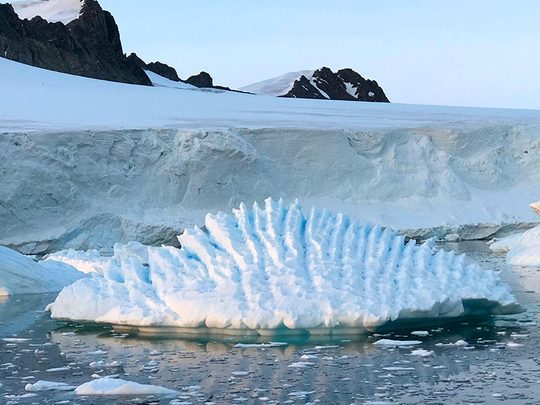
Antarctica: The Antarctic ice sheet lost nearly 3 trillion metric tonnes of ice from 1992 to 2017, and its rate of loss over that time tripled in West Antarctica, according to an international collaboration involving about 80 scientists.
The finding, published on Wednesday in the journal Nature, reveals that the continent's ice is shrinking at an unprecedented rate and could mean an even higher sea level rise by 2100. That would have serious implications for the environment and for people living in coastal regions around the world.
2.7trillion
|
"People should be concerned that Antarctica is clearly feeling the effects of climate change and it's responding to changes in ocean temperature," said lead author Andrew Shepherd, a glaciologist at the University of Leeds in England.
According to the overwhelming scientific consensus, the planet is warming at a rate accelerated by the greenhouse gases from human activity. Researchers have linked this rise in temperature to a host of consequences, including rising sea levels and shrinking polar ice reserves.
The ice sheets of Antarctica hold the vast majority of the planet's fresh water. Theoretically, if they melted entirely, sea level worldwide would rise by 190 feet, posing an existential threat to small island nations and coastal communities.
There are three different categories of ice: the ice sheet (enormous layers of ice that sit on land, whether that land is above or below sea level); the ice shelf (parts of the ice sheet that flow from the land into the ocean and begin to calve, or shed chunks of ice as icebergs) and sea ice (floating chunks of ice that grow and shrink with the seasons).
Researchers say each of these plays an important environmental role: The ice sheet holds enormous freshwater reserves, the ice shelves feed freshwater into the ocean, and the sea ice is more reflective of sunlight than the water it floats in, which reduces the amount of heat the planet absorbs.
Many studies have documented ice loss for Antarctica and Greenland, said Shepherd, who led two studies in a suite of papers on Antarctica released by Nature. But there are so many different studies that it's difficult to know which number to use, he said.
"There are about 150 different estimates of ice loss from Antarctica and Greenland and they use different methods, they cover different proportions of the ice sheets and they cover different time periods," Shepherd said. "You can always get a seemingly different number if you do it that way."
That's why the Ice Sheet Mass Balance Inter-Comparison Exercise, abbreviated as IMBIE, was established in 2011. It drew on satellite data and from scientists around the world to arrive at a single, well-documented estimate of ice loss since 1992.
This time, the collaboration repeated its work with data that include the years up to 2017.
The scientists used satellite data that relied on three different methods, measuring the ice's volume, its flow over the landscape and its gravitational attraction.
The researchers found that from 1992 to 2017, the Antarctic ice sheet lost around 2.7 trillion metric tonnes of ice, corresponding to an average sea level rise of 7.6 millimeters.
Between 1992 and 1997, ice sheet lost an average of 49 billion metric tonnes per year. From 2007 to 2012, the annual loss had widened to 160 billion metric tonnes.
But in the most recent period, from 2012 to 2017, the loss rate has grown to a whopping 219 billion metric tonnes every year -- about four-and-a-half times the rate just two decades ago.
This corresponded to a sea-level rise of 0.6 millimeters per year. That may sound small, but it's actually a significant contribution compared with the current overall estimated annual sea-level rise, which NASA says is 3.2 millimeters per year.
That increase has been driven largely by significant melting and loss from West Antarctica and the Antarctic Peninsula, as well as a slowdown in the growth of the East Antarctic ice sheet, the scientists said.
Over the entire 25-year period, West Antarctica's ice loss rate has risen from 53 billion metric tons per year to 159 metric tons annually. On the Antarctic Peninsula, ice loss has shot up from around 7 billion metric tonnes per year to 33 billion metric tonnes annually. The numbers are less certain for East Antarctica, which seems to have gained, not lost, ice over that period, though at a meager rate of 5 billion metric tonnes per year.
"What this is, is a really clear statement of how Antarctica is changing and where it's changing," said Robin Bell, a geophysicist at Columbia University's Lamont-Doherty Earth Observatory.
Bell, who was not involved in the study, said the paper was the "gold standard" in its methods and results.
190feet
|
There are reasons that the west and the peninsula fared worse than the east, Shepherd said.
East Antarctica's ice is largely above sea level, affected by sunlight and air temperature but not by water temperature.
The Antarctic Peninsula juts northward, where the air is warmer. That warm air melts ice into water which then flows into cracks in the ice, prying the fragments apart and causing it to fracture, Shepherd said.
As for West Antarctica, a mere half-degree Celsius increase in temperature was wreaking havoc on the glaciers there, he added. That's because warm water trapped deep beneath the surface was melting ice near the sea floor, essentially lifting glaciers just enough to reduce the friction between the ice and the ground.
"They flow more quickly into the ocean as a result of this melting," Shepherd said of the glaciers. "And that becomes a positive feedback [loop] because it's self-perpetuating."
The IMBIE findings could have serious implications for sea level rise over the coming century, the scientist said.
"In the past we've been persuaded of a narrative that sea level rise affects people in low-lying countries in the Pacific Ocean, and while that's devastating for them, it might not be a problem for a majority of the world's population,"
Shepherd said. "Well, in fact that's not the case; we know now that coastal cities flood when high-tide situations coincide with storms on top of the mean sea level."
219b
|
The next step, he added, will be to perform the same analysis for Greenland, to see where these northern ice reserves now stand.
The results could help researchers develop better models that could aid them in predicting what a future with shrunken ice sheets may look like, Bell said.
"It's one step on the way to improving our ability to tell people who live along the coast how fast sea level [will] change," she said.










_resources1_16a3106a819_small.jpg)

